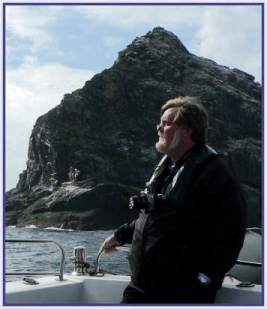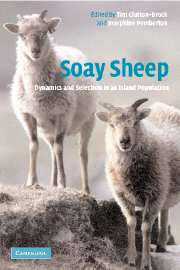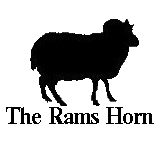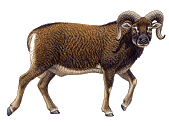
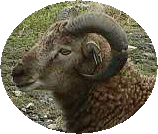

Soay Sheep
Soay Sheep
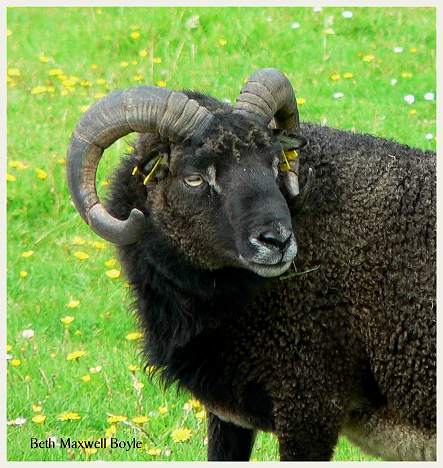 Soay Ram, St. Kilda, Scotland 2007
This breed takes its name from the Island of Soay which is part of the Saint Kilda Archipelago. There are still sheep living there. On August 17 of 2007 I had the privilege of making the trip by boat with my friend Dean to the Saint Kilda Archipelago and took the photographs you see on this Web page. The main Island of Hirta is where it is easiest to approach the sheep and these photos were taken on a glorious sunny day. As it happened it was sheep counting day for the scientists who study the Soay on Hirta. They have a permanent outpost on the Island so they can study these graceful little sheep. I had to be mindful not to meddle in the work they were doing on the steep slopes as I followed a group of ewes high above the harbor. I saw Soay Sheep at a farm park in Oban that displays rare breeds in 2005 but was eager to see them in their own environment. I had a very exciting day taking pictures of these sheep. I hope you enjoy the fruits of my labor.
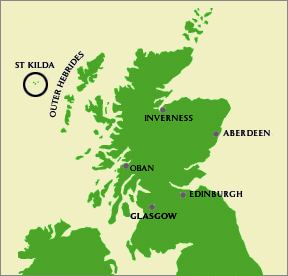 Soay sheep are a primitive breed of sheep (Ovis aries) that are descended from an isolated population of feral sheep on the 250-acre island of Soay in the Saint Kilda Archipelago. It is about 65 km from the Western Isles of Scotland. I left Leverburg on the Isle of Harris for Saint Kilda on a small boat with 8 other passengers early in the morning so I could see these fantastic creatures and explore the island. Amazingly these sheep are free of all cross breeding with modern sheep breeds. 120 of the sheep from Soay were relocated to the Island of Hirta when the humans were evacuated in 1932 and they flourish there. One of the scientists told me while I was there they have grown to number as many as 2000 some years. At one time the Islanders kept these sheep for their wool and meat but they were replaced in the 19th Century by the larger, woollier, Scottish Blackface sheep raised throughout Scotland. In a way the Soay came full circle as now the Island of Hirta is mostly just an Island of Soay sheep. Soay sheep are a window into the past and give us a road map to the Neolithic origins of domesticated sheep. It is believed by most researchers these sheep were established on Soay as a food source by Norse sailors many centuries ago.
 Background Information
Soay sheep in many ways are similar to the Mediterranean mouflon and the horned Urial sheep of Central Asia but their origins are uncertain. It is unknown whether they were established upon the island some time during the Bronze Age or perhaps by Vikings in the ninth and tenth centuries. The name of the island, 'Soay', is a corruption of Old Norse, meaning 'Island of Sheep'. This suggests they may have been introduced before the 10th Century. These sheep are much smaller than modern domesticated sheep and hardier. They are very swift and agile, and will flee to safety onto the high ground when startled. Their appearance is unique and very attractive. They tend to be either flax colored or dark brown with an off-white underbelly and rump. This was called 'lachdann' in the local Gaelic dialect. Some individuals are totally black or fawn-colored. A few sheep have white markings as well. In the early twentieth century, some Soay sheep were relocated to the mainland in order to establish exotic flocks, such as the famous flock of "Park Soay" at Woburn Abbey. The duke of Bedford began raising them in 1910, and selected breeding stock with the most "primitive" characteristics. Onehundred and twenty Soay sheep were relocated from Soay to the island of Hirta by the Marquess of Bute in the 1930s, after the human population was permanently evacuated. The Hirta population is unmanaged and has been the subject of scientific study since the 1950s. The sheep population on Hirta makes an ideal model subject for scientists researching evolution, population dynamics and demography because the population is unmanaged, closed (no emigration or immigration) and has no significant competitors or predators. Unlike most other large mammals, the Soay sheep population of Hirta in the St. Kilda archipelago show persistent oscillations, sometimes increasing or declining by more than 60% in a year. Currently, researchers from a number of universities and research institutes participate in a multidisciplinary study of factors affecting the population ecology of the sheep in Saint Kilda. This research has recently been published: Clutton Brock, T.H. & Pemberton J. (2004) Soay Sheep published by Cambridge University Press. ISBN 0521823005 .This book is currently available for those who are interested in further study, Soay Sheep: Dynamics and Selection in an Island Population from Amazon.com.
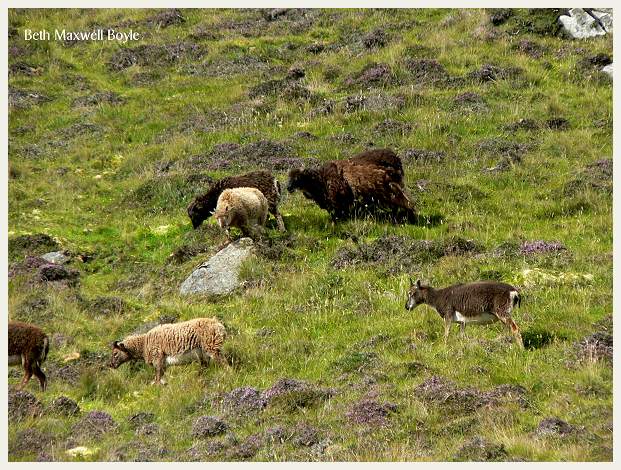 August Grazing on Hirta
Soay sheep have short tails and naturally shed their wool in the spring and summer. The ewes are polled, scurred or horned and rams are either horned or scurred. Scurs are very small, under developed horns that are brittle and slow growing. The Soay sheep are most commonly brown or tan with an off-white belly, rump patch and or patch under the chin. Occasionally random white markings on the face and or body and legs occur as well. Self-colored (solid color with no markings) black or tan individuals are seen in the mix on Hirta but are not as common in flocks that have been established on the mainland or in the US.
 The ewes when they molt look rather like tiny Musk oxen .
They often have large chunks of wool clinging to them in spring and summer
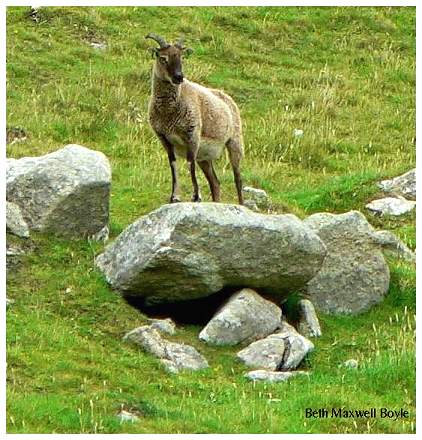 This noble ewe has a nice set of horns, she reminds me of the Chamois of the Alps
 Polled ewe and lamb
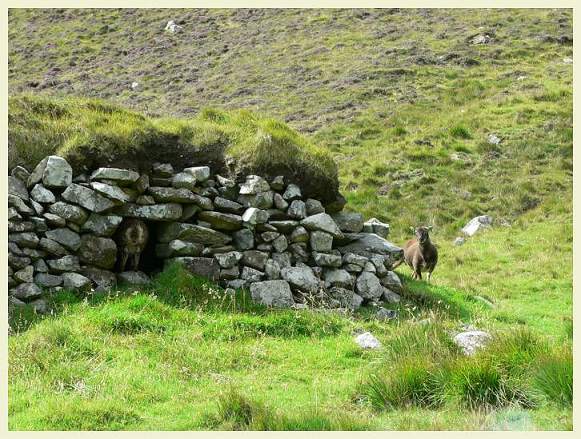 The ewes take shelter in the cleits the Islanders once used to store fodder and supplies.
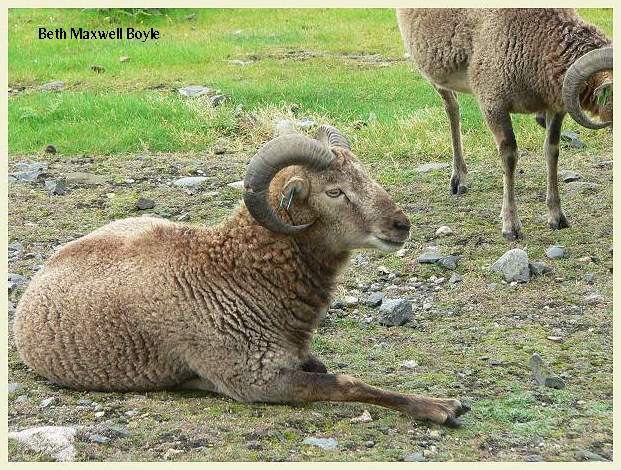 Young Rams
Video of Saint Kilda by Beth Maxwell Boyle
More Videos on the
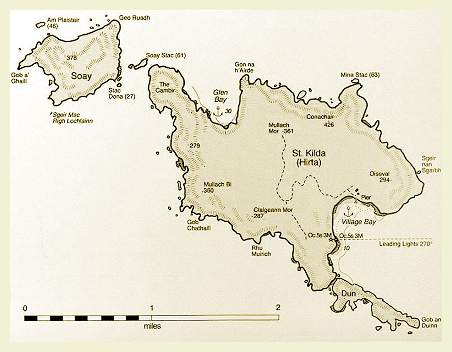 Links and Resources on Soay Sheep
(St. Kilda archipelago - Scotland)
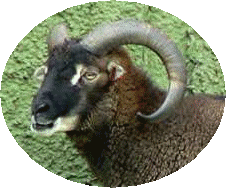 A Foot Note for Shepherds
The Rare Breed Survival Trust in the UK has been working to preserve Soay sheep on the mainland. It is possible to buy and raise them in the UK and some other parts of Europe. The stock currently being bred is descended from sheep brought to the mainland from Saint Kilda. If you want to own Soay Sheep and you live in the USA you need to bone up on the breed and be very watchful where you purchase your breeding stock. Surf the Net and compare the photos of sheep from Saint Kilda and the UK flocks with what you see offered for sale by breeders in the USA. Most American breeders are selling an amalgamated mixture of Soay, Mouflon, Jacob and Barbados Blackbelly sheep from old petting zoo bloodlines. When you see massive horns on the rams and big hairy throats on the rams you are looking at something that is not in fact a Soay sheep. Real Soay do not have much white spotting. In fact it's quite rare. The fact that an animal is registered does not make it a purebred, in many cases when dealing with rare breeds and fledgling registries. The breed is not well known in this country yet and this is a case where the buyer should beware. Don't be swayed by romantic stories and hype. Soay sheep are NOT hair sheep. They have wool that they naturally shed each spring. With time the breed very may well become better established in America and those who are interested in this fascinating breed will be able to breed the quality of animal seen in the UK. It can be a very costly mistake to buy second quality stock to begin with. There are some traits you cannot breed away from in one lifetime and what is the point of breeding a line that is nothing more than a cocktail of breeds from around the world. Shetlands, Icelandics and Barbado all have short tails so be careful what you think "proves" a specimen is full blooded. The best thing to do is ask questions and find out just where your potential breeder purchased his or her breeding stock and know just what you want to work towards in your breeding program.
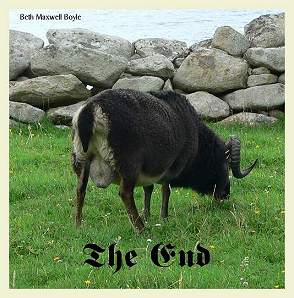 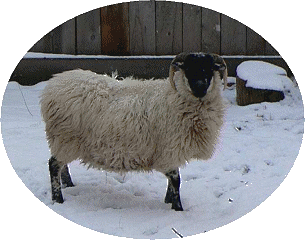 Videos for the Shepherd
Copyright 2007 , Beth Maxwell Boyle, All Rights Reserved
No part of this website may be used for any purpose ( including using images )
without written consent from The Rams Horn
|
Copyright 2007 , Beth Maxwell Boyle, All Rights ReservedNo part of this website may be used for any purpose ( including using images )without written consent from The Rams Horn

